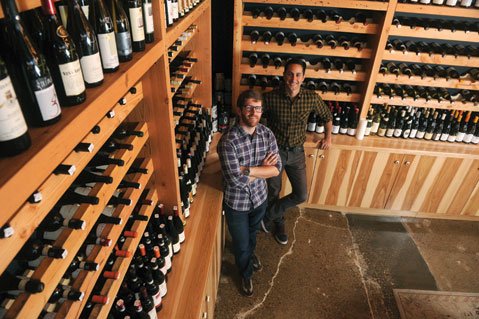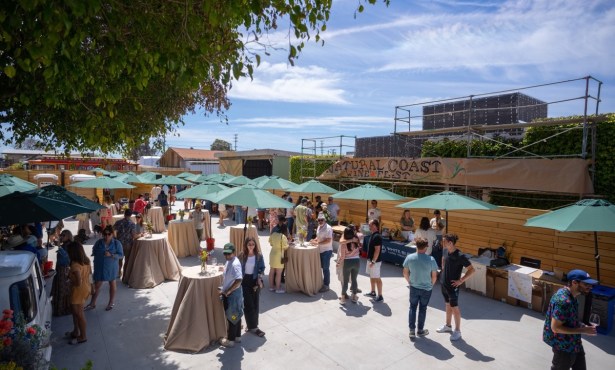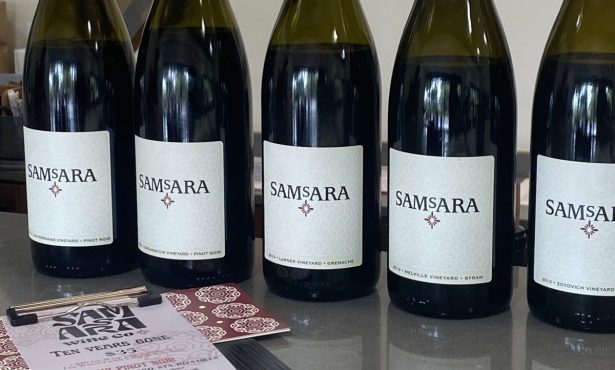The Prosperous Drought: 2013 Vintage Report
A Sommelier’s Predictions for Santa Barbara County Wines Harvested Last Year

When you think of drought, images of abundance and teeming life rarely follow. But Mother Nature has a tendency to make up the rules as she goes along. Every vintage of Santa Barbara County wine manages to keep the watchful vigneron on his or her proverbial toes. And quite emphatically, the harvest of 2013 was no exception. Here’s what to expect in the wines to come, including those that we are featuring at Les Marchands’ second annual wine futures tasting this Saturday, April 19.
Reliable Dogma
The sommelier profession is very much about packaging. Ask us about a wine or a vintage, and you get it short and sweet. Dissertations are rarely heeded table side — it’s three sentences or less and wrap it up with a neat little bow. But the truth of a vintage is never black-and-white, and the road to understanding is littered with dead ends.
“You can’t put it in a box,” says Justin Willett of Tyler Winery. “Every year, I make plans for what I want to do in the winery, and every year the vintage has its own ideas, and I’m forced to respond accordingly.” Mandy Grassini of Grassini Vineyards adds, “It’s kind of like life. You make plans, but it never really goes the way you expect. When you look back and try to figure out how you got there, you just kind of throw your hands up.”
There are just too many variables and too much about the natural world we just don’t understand, which is why, for those on the production side, adaptability is a skill set worth embracing. It is also why branding a vintage almost always leads to overgeneralization.
For the marketeers, however, two words encapsulate the 2013 harvest for Santa Barbara County and much of the state of California: early and often. Buds pushed through quickly. It was an early harvest with a bountiful crop. And the majority of the wines from the vintage should be accessible early.
Reader’s Digest Version
The story of 2013 was warm and dry. It started in the spring and seemed to linger right on through to harvest. In fact, in every single month from March through November, valley temperatures were above the historical average, and precipitation was below. Thankfully, the rest of the growing season was fairly problem free.
“There were no massive heat spikes to speak of,” said Eric Mallea of Sanford Winery. Said Ben Merz of Coastal Vineyard Care, “2013 had less frost incidents compared to a normal vintage.” The only material losses were found in some of the dry-farmed vineyards due to the lack of rainfall. The rest of the irrigated county reaped a rare bumper crop for the second straight year.
Harvest Time
According to Adam Tolmach of The Ojai Vineyard, “The last back-to-back big harvest was in ’78 and ’79.” The year 2012 was the Octomom, of harvests and the vines gave up all they had. The hope was for a rainy winter to replenish the soil and set the table for 2013. The rains never came, and the drought was so severe that by August, Gibraltar Dam on the Santa Ynez River was the lowest it has ever been since its construction in 1920.
It’s safe to say no one saw 2013 coming. I asked Chris Hammell, vineyard manager of Bien Nacido, at what point he knew the vintage was going to be big. “About two or three weeks before we picked,” he replied. That was the general consensus from the people I spoke with around the valley. Fast and furious — a reality lived out annually in more violent growing areas. But in one of the most temperate terroirs on planet Earth, there was more incentive than ever for the conditioned producer to keep his or her head on a swivel.
First-World Problems
You would be hard-pressed to find a vintage that illustrated better the brutality of supply and demand. The labor shortage in the valley is a real issue. Picking grapes isn’t as lucrative as picking other produce like blueberries. And in a year that demanded all hands on deck, some wineries simply did not have enough bodies to get all the fruit in when they wanted.
If you got your fruit in on time, the second concern was did you have enough vessels to start processing? Remember, many of the barrels and tanks were being occupied by the massive 2012 vintage. The bigger houses really have the upper hand in a musical-chairs scenario.
Jim Adelman of Au Bon Climat and Qupé notes that “managing quality in larger scale operations involves orchestrating everything weeks in advance.” Not only did Adelman have enough barrels and tanks on reserve, but the sheer nature of his workload requires production to be a well-oiled machine. The smaller outfits had their hands full. Some played a brilliant game of Tetris in the cellar. The less fortunate left their crop hanging until a vessel freed up.
Then there was the skin to juice ratio, which heavily favored the latter. Grapes are one thing — grape juice is another. And a good majority of winemakers had no idea how much wine they had on their hands until they started pressing. If necessity is the mother of invention, I’d like to believe, there were as many happy accidents in vintage ’13 as there were speed bumps. At the very least, two truths remain consistent: Mother Nature taught, and we learned.
Regional Highlights
Santa Maria Valley: It was cooler here than perhaps anywhere else in the valley aside from Sta. Rita Hills. Botrytis pressure was a bit higher than in vintages past but yields weren’t severely compromised overall. Several winemakers, including Trey Fletcher from Bien Nacido Vineyards, love their 2013 pinot noir.
Sta. Rita Hills: It was a warm year overall but very even. Yields were overall quite large — in some places bigger than ’12. There was one weird heat spell for a few days in the first week of September where evening temperatures nearly crept up to 80 degrees. This incident triggered the pick for a lot of the earlier producers. Ryan Zotovich loves his syrah. Rajat Parr of Sandhi and Gavin Chanin of Chanin Wines each sing the same tune with their pinot: ripeness and freshness.
Los Alamos: Though not quite an AVA yet, this lovely patch, sandwiched between Santa Maria and Santa Rita Hills will have its day. Graham Tatomer was able to utilize a steady supply of fogless days to draw out deep flavors from his Kick-On Ranch riesling. This is one of the better sites in the state for riesling and signals a bright future for the grape.
Ballard Canyon: Our newest AVA had perhaps the most moderate yields of any appellation. Much of this may be owed to the vigorous Rhône varieties that flourish here. There is less of a need to prune for a big crop. Coastal producers are under far more pressure to try to get all they can out of pinot and chard.
Happy Canyon: Sauvignon blanc was the first fruit to come in, per usual. The AVA is further inland and routinely can see triple-digit days. For those who wanted more intense fruit flavors out of cabernet sauvignon, they were not let down by the warmth and dryness that defines so many great Bordeaux and Napa vintages.
The Wines
After all this waxing on about shades of gray in a vintage, I suppose a little pigeonholing is in order. At the end of the day, all that really matters is this: What do the wines drink like? The soft answer: ripe and generous. The hard truth: It depends.
The best place to start, I suppose, is with a similar vintage for comparison. Luckily, 2012 does just nicely. Another big crop in a warm, dry year — fruit came in early and very clean. In both vintages, you could have sorted with your hands behind your back. So how does ’13 differ from ‘12?
Year of the Bluebird: There were more blue skies in ’13 than in recent memory. The fog that loves to hang out on the west end of the valley decided not to drift ashore too often this year, allowing photosynthesis to do its thing in a powerful way. As a result, the flavors coming out of ’13 are deep and well delineated.
The Acid Test: Do you like your apple green and tart or red and sweet? Such is the wine world’s raging debate: What is ripeness? Whatever side of the fence you lie on, viticulture 101 dictates that, as sugars spike in grapes, acid starts to fall out. In 2013 however, it appears that the grapes initially ripened faster than acid levels could respire. What does that mean? According to Ernst Storm of Storm Wines, it means that “the guys who typically pick early got what they were looking for: great freshness.” At a given point, however, nature equalized and acid fell out with a vengeance. Those producers that waited, gunning for that riper, juicier style also got what they wanted.
The Takeaway: If you played your cards right, 2013 was a vintage whose quality was not eclipsed by its quantity.
Lukewarm Predictions
All in all, it is amazing how evolved the 2013s are out of barrel. What they will become in bottle over time will be a joy to watch over the next decade plus. As we usher in 2014, the big picture points to the urgency of the continued drought and its implications on the water supply. With a warm, dry winter almost behind us, buds have been breaking as early as the first week of February. The smart money says to expect a light crop and another early harvest. But with Mother Nature at the helm, I’ll leave my cash in my pocket.
4•1•1
Brian McClintic is a Master Sommelier and the cofounder of Les Marchands Wine Bar & Merchant (131 Anacapa St., [805] 284-0380; lesmarchandswine.com), which is hosting their second annual Santa Barbara County Wine Futures tasting on Saturday, April 19, noon-4 p.m. Tickets are $70 in advance, $80 at the door.



